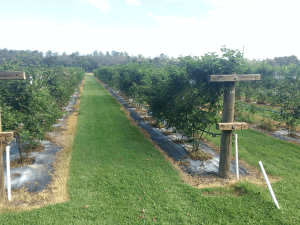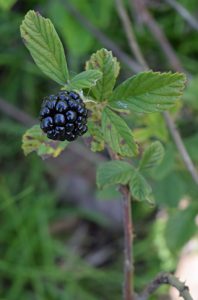Blackberries (Rubus spp.) will not quickly jump into your mind when you think of fruit production in Florida. In fact, when you do think of blackberries, you will most likely envision viny plants infiltrating your gardens and attacking you with their tiny spines. These are dewberries and are not known for large or consistent fruit. Though scientifically of the same name, bush varietals are a world apart. Bush blackberries fall into the rosacea or rose family. They are deciduous fruiting shrubs, generally acclimatized to temperate environments. Luckily for us, they will grow in the Panhandle though due to the frangible nature of the fruit are not widespread as an agronomic crop. With estimated production rates of 6000lb per acre in the rest of the country the potential brought to home food production is undeniable.

Blackberries have been heavily bred at the University of Florida, but as with all gardens, plant selection is key. The most critical factor in selecting blackberries is chill hour requirement. You may recall that chill hours are the total time below 45 degrees needed by a plant to set fruit the following spring. The vast majority of our area gets 660-700 chill hours per year on average with the extreme north end getting upwards of 800 hours per year. Once you have this issue figured out, the next concern is growth habits. Many grow erect and will not need trellising, but there are cultivars that vine and will need support. A final consideration for cultivar selection is whether or not they will need pollinator plants as an accompaniment. If the berries you want have this need, make sure you pick a compatible cultivar with a similar bloom time. Some of the cultivars that will do well in north Florida include ‘Arapaho’, ‘Chickasaw’, and ‘Choctaw.’
Plant blackberries over the winter months much as you would any deciduous fruits. Keep the roots moist if you will be storing the plant for any amount of time. Make sure the first main root is just above the soil line and remove any air pockets as you backfill the planting hole. Space the plants out according to their full size which varies based on cultivar. These have shallow root systems and are therefore not heavy feeders. As a result, apply nutrients in the spring of the year they’re planted at ¼ pound per plant. In subsequent years apply ¼ to ½ a pound per plant twice a year. Irrigation and weed control will also be critical in their first year. Keep the soil moist but not overly wet and avoid overhead watering. Irrigation will become less important once the shrubs establish in their location.

Growing food in your home landscape is a great way to reconnect with your property and bring your food system as local as possible. Blackberries are low-maintenance fruit that once established will provide years of production with minimal effort. For more information see this Ask IFAS document, or contact your local extension agent for additional information on this and any topic regarding your gardens and more.
 0
0
